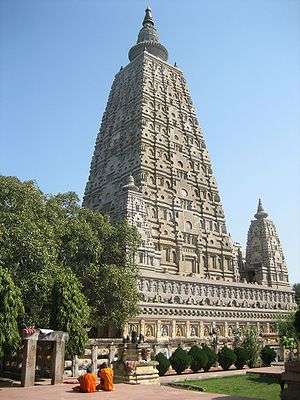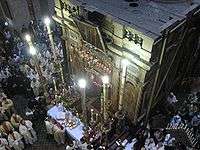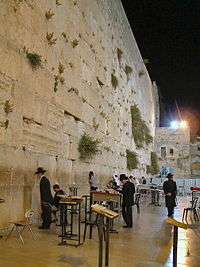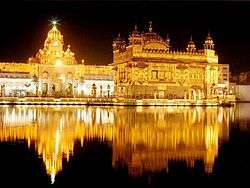Holy places
Holy places, (Loca sancta) are sites that a religion considers to be of special religious significance. They are usually places visited by pilgrims.
Baha'i
Located in Bahji near Acre, Israel, the Shrine of Bahá'u'lláh is the most holy place for Bahá'ís and their Qiblih, or direction of prayer. It contains the remains of Bahá'u'lláh, founder of the Bahá'í Faith and is near the spot where he died in the Mansion of Bahjí. The second holiest site is the Shrine of the Báb in Haifa.[1]
In Iran, the Baha'is possessed several important holy sites, including the House of the Bab in Shiraz; the House of Baha' Allah's father in Tehran; the shrine and grave of Quddus. Since the Revolution, all these places have been demolished, and a mosque has been built on the site of the Bab's house.
Buddhism

The Buddha is said to have identified four sites most worthy of pilgrimage for Buddhists, saying that they would produce a feeling of spiritual urgency. These are:[2]
- Bodh Gaya, India, is the most important religious site and place of pilgrimage, the Mahabodhi Temple houses what is believed to be the Bodhi Tree where the Buddha realized enlightenment and Buddhahood.
- Kushinagar, India, is where the Buddha attained Parinirvana after his death.
- Lumbini, Nepal, is where Queen Maya gave birth to Prince Siddhartha Gautama.
- Sarnath, India, is the deer park where the Buddha first taught the Dhamma after realizing enlightenment.
In the later commentarial tradition, four more sites were added to make Eight Great Places, places where a miraculous event is reported to have occurred:
- Sravasti: Place of the Twin Miracle, showing his supernatural abilities in performance of miracles. Sravasti is also the place where Buddha spent the largest amount of time, being a major city in ancient India.
- Rajgir: Place of the subduing of Nalagiri, the angry elephant, through friendliness. Rajgir was another major city of ancient India.
- Sankassa: Place of the descending to earth from Tusita heaven (after a stay of 3 months teaching his mother the Abhidhamma).
- Vaishali: Place of receiving an offering of honey from a monkey. Vaishali was the capital of the Vajjian Republic of ancient India.
There are various other locations in India and Nepal associated with the Buddha, and there are holy sites located throughout Asia for each Buddhist tradition, for instance in Afghanistan, Cambodia, China, India, Indonesia, Japan, Laos, Myanmar, Sri Lanka, South Korea and Thailand. Lhasa in Tibet contains many culturally significant Tibetan Buddhist sites such as the Potala Palace, Jokhang temple and Norbulingka palaces.
Christianity

In Christianity, the Holy places are significant because they are the place of birth, ministry, Crucifixion and Resurrection of Jesus of Nazareth, the Saviour or Messiah to Christianity.
| Al-Maghtas | |
|---|---|
| Name as inscribed on the World Heritage List | |
|
Al-Maghtas ruins on the Jordanian side of the Jordan River are the location for the Baptism of Jesus and the ministry of John the Baptist. | |
| Location |
Balqa Governorate Jordan |
| Type | Cultural |
| Criteria | iii, vi |
| Reference | 1446 |
| UNESCO region | Arab States |
| Inscription history | |
| Inscription | 2015 (39th Session) |
Holy cities for Christians of all denominations
- Jerusalem is believed to be the site of some of Jesus's teaching, the Last Supper, the subsequent institution of the Holy Eucharist as well as His entombment; Christians believe He was crucified on a nearby hill, Golgotha (sometimes called Calvary). It contains the Church of the Holy Sepulchre, Via Dolorosa, Mount Zion and the Dormition Abbey, and Gethsemane (with Mary's Tomb and the Church of All Nations).
- Nazareth is Jesus's hometown and the site of many holy places, including the Church of the Annunciation and Mary's Well.
- Bethlehem is the birthplace of Jesus.
- Qana is where Jesus made his first miracle (Turned the water into wine)
- Al-Maghtas, this site has been recognized as the original site where Jesus was baptized by all the major traditional Christian Churches. The site is in Jordan
- Machaerus, the Herodias fortress where John the Baptist was imprisoned and beheaded. The site is in Jordan
- Mount Nebo, traditional site of the death of Moses and where he looked over to the "promised land". The site is in Jordan
During the Crusades, Christian pilgrims often sought out the Holy Places in the Outremer, especially early in the 12th century immediately after Jerusalem was captured.[3] The Holy Places included sites in Jerusalem and Bethlehem as well as:
- Sephoria, where the Virgin Mary was said to have spent her childhood
- The River Jordan, site of Christ's baptism
- Cave dwelling of John the Baptist
- Syria
- Galilee (North Israel/South Lebanon)
- Sea of Galilee
- Mount Tabor, site of the Transfiguration of Jesus
- Jericho, along the road to which was the location of the Good Samaritan's charity.
- The Red Sea where Moses parted the sea in order to escape slavery
Confucianism
Holy places of Confucianism include Temple of Confucius, Cemetery of Confucius and the Kong Family Mansion in Qufu, Shandong Province of China.
Druidism

Stonehenge is a site of religious significance in Neo-Druidism. Druids perform pilgrimage there, The first modern Druids to make ceremonies at this site is the Ancient Order of Druids.
Hinduism
The Seven Ancient Holy Towns are Ayodhya, Mathura, Haridwar, Varanasi, Kanchipuram, Dvārakā, and Ujjain.
The Four Holy Dhamas (Char Dham to Smartas)
- Puri (East)
- Rameshwaram (South)
- Dvārakā (West)
- Badrinath (North)
The Four Maha Kumbha Mela sites
- Mathura/Vrindavana
- Dvaraka (Dwarka)
- Badrinath
- Puri (Jagannatha Puri)
- Tirupati
- Ayodhya
- Nathdwara
- Udupi
Kaumaram(Arupadaiveedu (Six sacred abodes of Murugan; Tamil
ஆறுபடை வீடு)
- Thiruthani Murugan Temple
- Swamimalai Murugan Temple
- Palani Murugan Temple
- Pazhamudircholai Murugan Temple
- Thirupparamkunram Murugan Temple
- Thiruchendur Murugan Temple
Shaktas (Shakti piths)
- Kanyakumari
- Madurai
- Vaishno Devi
- Calcutta (Kali Temple)
- Note that there are 51 principle Shakti sites throughout India
Islam
The three holiest sites in Islam are the Masjid al-Haram, or Grand Mosque, (in Mecca) ; the Al-Masjid al-Nabawi, or Prophet's Mosque, (in Medina)and Al-Aqsa Mosque in Jerusalem. Every year millions of Muslims from all over the world visit Masjid al-Haram and Al-Masjid al-Nabawi to perform Hajj. Muslims are also required, if physically able, to undertake a pilgrimage to Mecca at least once in one's life: it is strongly recommended to do it as often as possible, preferably once a year. Only individuals whose financial position and health are severely insufficient are exempt from making Hajj (e.g. if making Hajj would put stress on one's financial situation, but would not end up in homelessness or starvation, it is still required). During this pilgrimage, the Muslims spend three to seven days in worship, performing several strictly-defined rituals, most notably circumnavigating the Qaaba among millions of other Muslims and the "stoning of the devil" at Mina. At the end of the Hajj, the heads of men are shaved, sheep and other halal animals, notably camels, are slaughtered as a ritual sacrifice by bleeding out at the neck according to a strictly-prescribed ritual slaughter method similar to the Jewish kashrut, to commemorate the moment when, according to Islamic tradition, Allah replaced Abraham's son Ishmael (contrasted with the Judaeo-Christian tradition that Isaac was the intended sacrifice) with a sheep, thereby preventing human sacrifice. The meat from these animals is then distributed locally to needy Muslims, neighbors and relatives.
The next two holiest sites in Shia Islam are the Imam Ali Mosque and the Imam Husayn shrine.
Judaism

In Jewish tradition, the Temple Mount is regarded as the place where God chose the Divine Presence to rest. Jewish tradition regards the Mount, or the Foundation Stone, as the location of a number of important events mentioned in the Bible, including the location from which the world expanded into its present form, Abraham's binding of Isaac, Jacob's dream,[4] the threshing floor which King David purchased from Araunah the Jebusite,[5] and the location of the two Jewish Temples. Jewish texts record that the Mount will be the site of the Third Temple, which will be rebuilt with the coming of God.
The Temple Mount is the holiest site in Judaism and is the place to which Jews turn during prayer. Due to its extreme sanctity, many Jews will not walk on the Mount itself, to avoid unintentionally entering the area where the Holy of Holies stood. The Temple is mentioned extensively in Orthodox services. Conservative Judaism mentions the Temple and its restoration, but not its sacrifices. The destruction of the Temple is mourned on the Jewish fast day of Tisha B'Av. Due to religious restrictions on entering the most sacred areas of the Temple Mount (see following section), the Western Wall, a retaining wall of the Temple Mount and remnant of the Second Temple structure, is considered by some rabbinical authorities the holiest accessible site for Jews to pray.
Jerusalem is also the holiest city in Judaism, and the spiritual center of the Jewish people since the 10th century BCE.[6] The Four Holy Cities in Jewish tradition are the cities of Jerusalem, Hebron, Tiberias, and Safed: "Since the sixteenth century the Holiness of Palestine, especially for burial, has been almost wholly transferred to four cities—Jerusalem, Hebron, Tiberias, and Safed."[7]
Sikhism

Sri Harmandir Sahib, also known as Sri Darbar Sahib or Golden Temple, (on account of its scenic beauty and golden coating for English speaking world), is named after Hari(God) the temple of God. The Sikhs all over the world, daily wish to pay visit to Sri Amritsar and to pay obeisance at Sri Harmandir Sahib in their Ardas.
Guru Arjan Dev, the Fifth Nanak, conceived the idea of creating a central place of worship for the Sikhs and he himself designed the architecture of Sri Harmandir Sahib. Earlier the planning to excavate the holy tank (Amritsar or Amrit Sarovar) was chalked out by Guru Amardas Sahib, the Third Nanak, but it was executed by Guru Ram Das Sahib under the supervision of Baba Budha ji. The land for the site was acquired by the earlier Guru Sahibs on payment or free of cost from the Zamindars (landlords) of native villages. The plan to establish a town settlement was also made. Therefore, the construction work on the Sarovar(the tank) and the town started simultaneously in 1570. The work on both projects completed in 1577 AD.
Guru Arjan Dev Sahib got its foundation laid by a Muslim saint Hazrat Mian Mir ji of Lahore on 1st of Magh, 1645 Bikrmi Samvat(December,1588). The construction work was directly supervised by Guru Arjan Sahib himself and he was assisted by the prominent Sikh personalities like Baba Budha ji, Bhai Gurdas ji, Bhai Sahlo ji and many other devoted Sikhs.
Unlike erecting the structure on the higher level(a tradition in Hindu temple architecture), Guru Arjan Sahib got it built on the lower level and unlike Hindu Temples having only one gate for the entrance and exit, Guru Sahib got it open from four sides. Thus he created a symbol of new faith, Sikhism. Guru Sahib made it accessible to every person without any distinction of Caste, creed, sex and religion.
The building work completed in 1601 AD on Bhadoon Sudi 1st, 1661 Bikrmi Samvat (August/September,1604). Guru Arjan Sahib installed newly created Guru Granth Sahib, in Sri Harmandir Sahib and appointed Baba Budha ji as its first Granthi i.e. the reader of Guru Granth Sahib. After this event it attained the status of ‘Ath Sath Tirath’. Now the Sikh Nation had their own Tirath, a pilgrimage center
Sri Harmandir Sahib, is built on a 67 ft. square platform in the center of the Sarovar(tank). The temple itself is 40.5 ft. square. It has a door each on the East, West, North and South. The Darshani Deori (an arch) stands at the shore end of the causeway. The door frame of the arch is about 10 ft in height and 8 ft 6 inches in breath. The door panes are decorated with artistic style. It opens on to the causeway or bridge that leads to the main building of Sri Harmandir Sahib. It is 202 feet in length and 21 feet in width.
The bridge is connected with the 13 feet wide ‘Pardakshna’ (circumlocutory path). It runs round the main shrine and it leads to the ‘Har ki Paure’ (steps of God). On the first floor of ‘Har ki Paure’, there is continuous reading of Guru Granth Sahib.
The main structure of Sri Harmandir Sahib, functionally as well as technically is a three-storied one. The front, which faces the bridge, is decorated with repeated cuspid arches and the roof of the first floor is at the height of the 26 feet and 9 inches.
At the top of the first floor 4 feet high parapet rises on all the sides which has also four ‘Mamtees’ on the four corners and exactly on the top of the central hall of the main sanctuary rises the third story. It is a small square room and have three gates. A regular recitation of Guru Granth Sahib is also held there.
On the top of this room stands the low fluted ‘Gumbaz’(dome) having lotus petal motif in relief at the base inverted lotus at the top which supports the ‘Kalash’ having a beautiful ‘Chhatri’ at the end.
Its architecture represents a unique harmony between the Muslims and the Hindus way of construction work and this is considered the best architectural specimens of the world. It is often quoted that this architecture has created an independent Sikh school of architecture in the history of art in India.
Taoism
Four sacred mountains of Taoism:
Wudang Mountains, in Shiyan, Hubei Province of China;
Mount Qingcheng, in Dujiangyan, Sichuan Province;
Mount Longhu, in Yingtan, Jiangxi Province;
Mount Qiyun, in Huangshan, Anhui Province.
See also
References
- ↑ "Holy Places of the World". adherents.com.
- ↑ The Buddha mentions these four pilgrimage sites in the Mahaparinibbana Sutta. See, for instance, Thanissaro (1998) and Vajira & Story (1998).
- ↑ Sean Martin, The Knights Templar: The History & Myths of the Legendary Military Order, 2005. ISBN 1-56025-645-1
- ↑ Toledot 25:21
- ↑ 2 Samuel 24:18–25
- ↑ Why Do Jews Love Jerusalem? by Yeruchem Eilfort. Chabad.org/ Ideas & Beliefs/Questions & Answers/Mitzvot & Jewish Customs
- ↑ Palestine, Holiness Of by Joseph Jacobs, Judah David Eisenstein. Jewish Encyclopedia, 1906 ed.
External links
- A Journey Through the Holy Lands (Photo Gallery) IslamOnline.net

